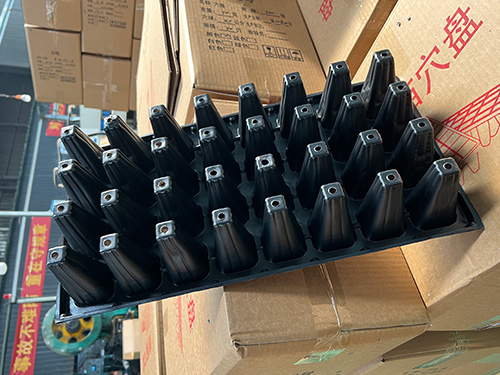How to Choose the Right Seedling Tray for Different Types of Plants
2024-09-24 13:37:12
In agricultural production, choosing the right seedling tray is crucial for improving planting efficiency and plant growth quality. Different types of plants have varying needs when it comes to seedling trays. This article will explore how to select the most suitable seedling tray based on the plant species, helping you achieve the best results in the seedling process.

I. Why Choosing the Right Seedling Tray is Crucial
Seedling trays play an important role in modern agriculture by providing a stable growing environment, saving space, and increasing germination rates. However, the growth patterns of roots, sowing depth, and space requirements differ among plant species. Choosing the appropriate seedling tray can directly impact the success of your seedling process.
II. Selecting Seedling Trays Based on Root Characteristics
1. Shallow-rooted Plants:
Examples include lettuce, spinach, and cilantro. These plants have shallow root systems and generally require smaller, shallower trays. Choosing trays with smaller cell sizes, such as 72-cell or 98-cell trays, can effectively save space while providing enough room for seedlings to grow.
2. Medium-rooted Plants:
Plants like tomatoes, eggplants, and peppers have moderately developed roots. These plants need a deeper growing space during the seedling phase. Medium-sized trays, such as 50-cell or 72-cell trays, are recommended. Deeper tray cells help roots develop fully and provide sufficient nutrients.
3. Deep-rooted Plants:
Plants like melons and beans have deep root systems, which require larger growing spaces during the seedling stage. Opt for larger cell sizes, such as 32-cell or 50-cell trays, to ensure the roots have enough depth to grow without tangling, which can impact transplant success later.
III. Choosing Seedling Trays Based on Growth Cycle
1. Short-growing Cycle Plants:
For plants with a short growth cycle, such as lettuce and cilantro, which are quickly transplanted after sowing, smaller-cell trays are ideal. They help concentrate germination in a short time and make management easier. Typically, 98-cell or 128-cell trays are suitable for these crops.
2. Long-growing Cycle Plants:
For crops like tomatoes and eggplants that require a longer seedling period, opt for trays with larger cells and moderate depth. A 50-cell or 72-cell tray provides enough space for seedlings to develop stronger root systems during the seedling phase.
IV. Selecting Seedling Trays Based on Seed Size
1. Small-seeded Plants:
For crops with smaller seeds like strawberries, herbs, and lettuce, trays with smaller cells are recommended. These ensure appropriate sowing depth for each seed and prevent wastage of seeds and growing media. A 128-cell or 98-cell tray is ideal for such plants.
2. Large-seeded Plants:
Plants with larger seeds, such as melons, pumpkins, and corn, require larger cell sizes and deeper tray cells. It’s best to use 32-cell or 50-cell trays, providing enough space for germination and allowing ample room for root growth.
V. Other Factors to Consider When Choosing Seedling Trays
1. Material:
Common seedling tray materials include plastic and foam. Plastic trays are durable and easy to clean, making them suitable for repeated use. Foam trays offer excellent insulation, making them ideal for crops that need warmer environments.
2. Drainage:
Since different plants have varying water needs, consider the drainage design when selecting a seedling tray. Good drainage helps prevent water accumulation, reducing the risk of root rot and promoting healthy seedling growth.
3. Airflow:
Trays with good airflow promote better root respiration and seedling development. It’s advisable to choose trays made from breathable materials or those with an airflow-friendly design.
VI. Conclusion
Choosing the right seedling tray can improve germination rates, promote healthy seedling growth, and ultimately increase crop yields. By considering factors such as root characteristics, growth cycle, and seed size, along with the tray’s material, drainage, and breathability, you can select the most suitable seedling tray for different plant types.
If you have any questions about selecting seedling trays or need to purchase high-quality trays, feel free to contact us. We provide top-quality products and professional advice to help you achieve better results in agricultural production.

The CNC Seed Braiding Machine is a high-precision, fully automated agricultural equipment s...

It adopts electrical integration and can be started by pressing the fully automatic button ...

The XP750 seeder has stable performance, excellent product quality, simple and convenient o...

It adopts electrical integration and can be started by pressing the fully automatic button ...



